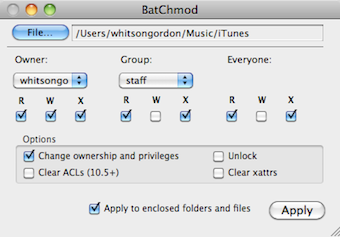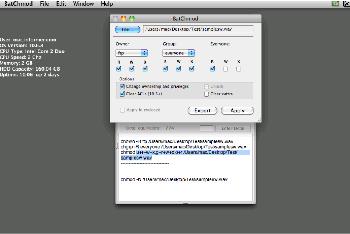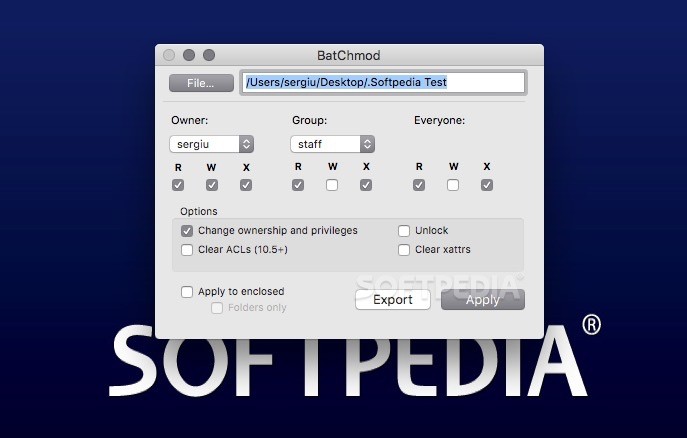BatChmod is a utility for manipulating file and folder privileges in Mac OS X. It allows the manipulation of ownership as well as the privileges associated to the Owner, Group or others. It can also unlock files in order to apply those privileges and finally, it can remove any ACLs added to a folder or file under Mac OS X 10.5 Leopard or better. New BatChmod OS X El Capitan usenet file sharing last version 10.11.6 BatChmod (1.6.3 / 1.7 Beta 5) file sharing free version BatChmod Mega DepositFiles MacOS new BatChmod 1.6.3 / 1.7 Beta 5 repack format zip format rar 10.10 Yosemite download BatChmod nulled filelist 10.10 Yosemite sendspace.
- Batchmod Osx Download
- Batchmod Omnisphere
- Batchmod Osx 10
- Batchmod Osx Emulator
- Batchmod Osx Free
- Batchmod Osx App
- Unfortunately Mac OS X does not have the getfacl and setfacl commands, as they have rolled ACL handling into chmod. Chmod -E accepts a list of ACLs on stdin, but I haven't found a command that will spit out ACLs in a suitable format on stdout.
- How to run properly chmod in OSX with C#? Ask Question Asked 1 year, 8 months ago. Active 1 year, 8 months ago. Viewed 345 times -1. I have the same problem as here How run chmod in OSX with C#. I would like to change permission via code in Unity I tried.
What is (Beta 10A190) Mac OS 10.6 Snow Leopard PowerPC? Back in the late transition days from PPC to Intel Apple had to eventually cut the rope for PPC. When early reports of developer beta builds of Snow Leopard surfaced, Apple neither clarified nor commented on the further PPC support of OS X beyond Leopard. But when the golden master was handed out it was clear — and communicated by then — that support for PPC was finally dropped. Things rested for years at that point (at least to my knowledge; Apple engineers knew better for sure). Then, mid-March 2020 I was hinted to a tweet by tesco@system2048 who posted a screenshot of a working SL-PPC This information sourced from this MacRumors thread: https://forums.macrumors.com/threads/snow-leopard-on-unsupported-ppc-machines.2232031/ The easy way:Below, the file PPC_SL_10A190.dmg is a bootable disk image of a system just after successful installation. Simply restore this image to a disk or partition using Disk Utility, and you can boot into the first time setup of a working Snow Leopard PPC install. Note that you will need to select 'erase destination' when doing the restore from the DMG file to ensure that the image is properly bootable. For more information, watch the 6 minute video walkthrough of the process above. The advanced way:Obviously, a PowerPC machine is pre-requisite. A copy of a developer build of 10.6 (server or client) will be needed, in addition to a handful of original kernel extensions from 10.5.8, a USB drive (or even better, a firewire hard disk), and a helper system in form of a Mac capable of running 10.6 out-of-the box (e.g., MacBook 1,1 to 4,1, etc.). Generally, G4 and G5 machines capable of booting from external USB or Firewire drives should be able to install 10.6 Initial patches to set up working installer media This shell script will patch the installer to boot properly: https://github.com/julian-fairfax/osx-sl-patcher 10.6_snowleopard_10a190_clientdvd.iso(7533.72 MiB / 7899.68 MB) / ISO image 164 / 2020-05-01 / 65097453a0b028293a41067b4e0b7d9f8bc14efc / / PPC_SL_10A190.dmg(3254.47 MiB / 3412.56 MB) Bootable DMG image of an installed system / DMG image 296 / 2020-05-13 / 3b4b1504373ea8f29c99b9f3bb7933348fb7527b / / Architecture
Emulating this? It should run fine under: QEMU |
As a general Mac user, hopefully you’ll never need to get into manually fixing permissions and ACL settings on files buried in your Mac OS. But if you do, what are the options?
There are plenty of instructions on the Internet giving the details of changing permissions in Finder and in Terminal. Terminal provides options more powerful that what Finder provides. But it’s complicated. I was looking for a free or cheap app to give me full control over permissions and ACL settings for any file on my Mac. I found exactly what I needed.
Batchmod Osx Download
Introducing PropEdit
PropEdit (USD$5)
UPDATE: The developer of this app is kindly making it available free, as he is no longer developing it. I am using it on Mountain Lion 10.8.3 with no issues, to my knowledge. You can legally use the following key to register it: 0GYF-CMX2-49X3-B1VH-8CA9 – Thank you to Jonas for pointing this out in the comments.
PropEdit is a great tool for doing exactly what I described above. You can do all of the following with it, and more:
Batchmod Omnisphere
- Add and remove users associated with a file/folder
- Change all flags of a file/folder. Flags such as archive, hidden, No Dump, Opaque, etc.
- Edit the ACL (Access Control List) for any file/folder. This is where you can add and remove users, groups, etc., who have access to a file/folder, and specify exactly what rights they have.
- Change the owner
I was having issues with a file utilised by the Sparkle update system. I noticed it had something like 5 ACL entries for my user name, and I wanted to remove them and clear it up. Here’s a screen shot of PropEdit whilst I was access the file:
You’ll notice the ACL Editor button to the bottom right. That’s where I got access to the messed up ACL settings, cleaned them out, and set new ones.
Here is a picture of the built-in ACL editor:
Batchmod Osx 10
PropEdit does cost $5, and there are numerous free alternatives to perform similar functions. None of the alternatives I tried were quite a polish and comprehensive as PropEdit, but if you only need to do a once-off repair I am sure these free apps will work just fine. Below are notes for apps I tried.
Batchmod Osx Emulator
Other Options (all free)
There are quite a few applications providing the kind of functionality I have detailed for PropEdit. Here is a list:

BatChmod (free) – It doesn’t have a full ACL editor. But otherwise allows you to clear all ACL settings. It doesn’t allow for setting Flags. The following image shows what it can do:
ACL Fix (free) – solely for removing all ACL settings from a folder, file, or batch of files/folders. Nice and simple if you need to resolve ACL issues on folders copied into a system from a backup, for instance.
Sandbox (free) – This app is still not as nice as PropEdit. It does give access to full ACL editing though, and setting of standard permissions. The file browser it uses is not the default Cocao/OS X one, so it is not possible to use the Go To Folder keyboard shortcut. This means if you need to edit a deeply buried file, which you have already located in Finder, you can’t simply copy its full path and then use Go To Folder in Sandbox to jump directly there. Xbox peripherals mobile phones & portable devices driver download for windows.
In my experience Sandbox is the best free option. It is almost as good as PropEdit, but without the $5 pricetag. If I was working with file permissions and ACL settings a lot, I would go with PropEdit. But otherwise I’d use Sandbox.
Batchmod Osx Free

PrivilegeFix (free) – discontinued

Batchmod Osx App
Related articles
